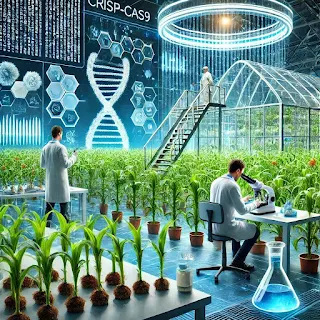Introduction
The global agricultural sector faces increasing challenges, including climate change, soil degradation, and the emergence of new crop diseases. Traditional breeding methods, while effective, are often time-consuming and imprecise. However, advancements in gene-editing technology, particularly CRISPR-Cas9, are revolutionizing the way scientists enhance crop resilience, nutritional value, and overall agricultural sustainability.
CRISPR-Cas9, a powerful gene-editing tool, allows for precise modifications in plant genomes, helping to develop crops that are resistant to diseases, pests, and environmental stresses. This article explores the applications of CRISPR-Cas9 in crop improvement, the benefits it offers, and the potential challenges facing its widespread adoption.
Understanding CRISPR-Cas9 and Its Role in Agriculture
1. What Is CRISPR-Cas9?
CRISPR-Cas9 (Clustered Regularly Interspaced Short Palindromic Repeats) is a revolutionary gene-editing technology derived from bacterial defense mechanisms. It consists of two key components:
Cas9 Enzyme: Acts as molecular scissors that cut DNA at a targeted location.
Guide RNA (gRNA): Directs Cas9 to the specific genetic sequence to be edited.
2. How CRISPR-Cas9 Works in Crop Modification
Scientists use CRISPR-Cas9 to:
Identify and target a specific gene in the plant genome.
Make precise genetic edits by adding, deleting, or modifying DNA sequences.
Enhance desirable traits, such as improved disease resistance, drought tolerance, and increased nutritional content.
By enabling precise modifications, CRISPR-Cas9 accelerates the breeding process and offers a more targeted approach compared to traditional breeding techniques.
Applications of CRISPR-Cas9 in Crop Improvement
1. Enhancing Disease Resistance
Crop diseases caused by bacteria, fungi, and viruses lead to significant agricultural losses worldwide. CRISPR-Cas9 helps combat these threats by:
Modifying plant immunity genes to enhance natural defense mechanisms.
Disrupting pathogen susceptibility genes to prevent infections.
Developing virus-resistant crops, such as CRISPR-modified cassava resistant to cassava mosaic disease.
2. Improving Nutritional Content
CRISPR-Cas9 allows scientists to enhance the nutritional value of crops by:
Increasing vitamin and mineral levels in staple foods like rice and wheat.
Reducing allergens and anti-nutrients to make crops more digestible.
Enhancing protein and essential amino acid content to improve dietary value.
For example, researchers have used CRISPR to develop tomatoes with higher antioxidant levels and rice with reduced arsenic accumulation.
3. Boosting Crop Yield and Growth Efficiency
With the growing global population, increasing crop yield is a priority. CRISPR-Cas9 contributes to higher yields by:
Enhancing photosynthesis efficiency to maximize plant growth.
Reducing growth inhibitors that slow down plant development.
Improving seed germination rates and plant vigor.
4. Developing Climate-Resilient Crops
Extreme weather conditions, such as droughts and floods, threaten global food security. CRISPR-Cas9 helps develop climate-resilient crops by:
Introducing drought-resistant genes to improve water-use efficiency.
Strengthening salt tolerance mechanisms to enable crops to grow in saline soils.
Enhancing heat tolerance for better survival in high temperatures.
5. Reducing Dependence on Chemical Pesticides and Fertilizers
By improving natural resistance to pests and diseases, CRISPR-edited crops reduce the need for chemical pesticides, promoting sustainable farming. Similarly, CRISPR-modified crops that efficiently absorb and utilize nutrients decrease reliance on chemical fertilizers, reducing environmental pollution.
Benefits of CRISPR-Cas9 in Agriculture
1. Precision and Efficiency
CRISPR-Cas9 enables highly accurate genetic modifications compared to traditional breeding techniques, which often involve random mutations.
2. Faster Development of Improved Crops
Gene-editing significantly accelerates the breeding process, reducing the time needed to develop improved crop varieties from decades to a few years.
3. Cost-Effective and Accessible
Unlike older genetic modification (GM) methods, CRISPR is relatively inexpensive and accessible to researchers worldwide, making it a viable option for both large-scale agriculture and smallholder farmers.
4. Environmentally Friendly
CRISPR-engineered crops reduce the need for harmful agrochemicals, contributing to eco-friendly and sustainable farming practices.
5. Potential to Address Global Food Security
By enhancing crop resilience, yield, and nutritional value, CRISPR-Cas9 technology plays a vital role in ensuring food security for a growing population.
Challenges and Ethical Considerations
1. Regulatory Uncertainty
Different countries have varying regulations regarding gene-edited crops:
The United States does not classify CRISPR-edited crops as GMOs if no foreign DNA is introduced.
The European Union currently regulates CRISPR-modified crops under strict GMO laws.
Developing nations face challenges in implementing consistent regulatory frameworks.
2. Public Perception and Acceptance
Despite its benefits, some consumers are hesitant about gene-edited foods due to concerns about safety, ethics, and long-term effects. Public education and transparent communication are essential to increasing acceptance.
3. Potential Unintended Genetic Effects
While CRISPR is precise, unintended genetic changes can still occur. Ongoing research is required to minimize off-target effects and ensure crop safety.
4. Intellectual Property and Accessibility Issues
CRISPR-Cas9 patents and licensing costs may limit its widespread use, particularly for small-scale farmers in developing countries.
The Future of CRISPR-Cas9 in Agriculture
1. Expanding Crop Varieties and Applications
Future research will focus on applying CRISPR to a broader range of crops, including:
Perennial plants, such as fruit trees and coffee.
Essential crops like wheat, rice, and maize.
Specialty crops, including medicinal and aromatic plants.
2. Integration with Other Biotechnologies
Combining CRISPR with artificial intelligence (AI), machine learning, and big data analytics will further enhance precision agriculture and crop breeding.
3. Advancements in CRISPR Techniques
Emerging CRISPR technologies, such as base editing and prime editing, will allow even more precise genetic modifications with fewer risks.
4. Policy Development and Global Collaboration
Governments, scientists, and industry leaders must work together to establish clear, science-based regulations that promote innovation while addressing safety and ethical concerns.
Conclusion
CRISPR-Cas9 is revolutionizing crop improvement by offering precise, efficient, and cost-effective solutions to enhance disease resistance, increase nutritional value, and improve climate resilience. While challenges remain, ongoing research and responsible policy development will ensure the safe and widespread adoption of this transformative technology.
As the demand for sustainable agriculture grows, CRISPR-Cas9 holds immense potential to shape the future of global food production, addressing food security challenges while reducing the environmental impact of farming. By embracing these advancements, we move closer to a more resilient and sustainable agricultural system.

No comments:
Post a Comment